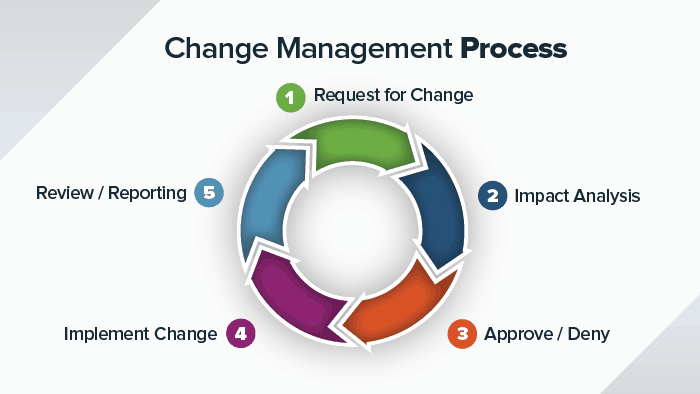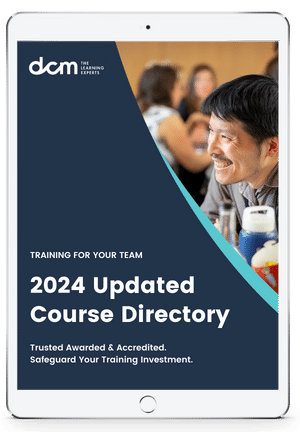Your organization is constantly experiencing change. Whether caused by new technology implementations, process updates, compliance initiatives, reorganization, or customer service improvements, change is constant and necessary for growth and profitability. A consistent change management process will aid in minimizing the impact it has on your organization and staff.
Below you will find 8 essential steps to ensure your change initiative is successful.
1. Identify What Will Be Improved
Since most change occurs to improve a process, a product, or an outcome, it is critical to identify the focus and to clarify goals. This also involves identifying the resources and individuals that will facilitate the process and lead the endeavour. Most change systems acknowledge that knowing what to improve creates a solid foundation for clarity, ease, and successful implementation.
2. Present a Solid Business Case to Stakeholders
There are several layers of stakeholders that include upper management who both direct and finance the endeavour, champions of the process, and those who are directly charged with instituting the new normal. All have different expectations and experiences and there must be a high level of "buy-in" from across the spectrum. The process of onboarding the different constituents varies with each change framework, but all provide plans that call for the time, patience, and communication.
3. Plan for the Change
This is the "roadmap" that identifies the beginning, the route to be taken, and the destination. You will also integrate resources to be leveraged, the scope or objective, and costs into the plan. A critical element of planning is providing a multi-step process rather than sudden, unplanned "sweeping" changes. This involves outlining the project with clear steps with measurable targets, incentives, measurements, and analysis. For example, a well-planed and controlled change management process for IT services will dramatically reduce the impact of IT infrastructure changes on the business. There is also a universal caution to practice patience throughout this process and avoid shortcuts.
4. Provide Resources and Use Data for Evaluation
As part of the planning process, resource identification and funding are crucial elements. These can include infrastructure, equipment, and software systems. Also consider the tools needed for re-education, retraining, and rethinking priorities and practices. Many models identify data gathering and analysis as an underutilized element. The clarity of clear reporting on progress allows for better communication, proper and timely distribution of incentives, and measuring successes and milestones.
5. Communication
This is the "golden thread" that runs through the entire practice of change management. Identifying, planning, onboarding, and executing a good change management plan is dependent on good communication. There are psychological and sociological realities inherent in group cultures. Those already involved have established skill sets, knowledge, and experiences. But they also have pecking orders, territory, and corporate customs that need to be addressed. Providing clear and open lines of communication throughout the process is a critical element in all change modalities. The methods advocate transparency and two-way communication structures that provide avenues to vent frustrations, applaud what is working, and seamlessly change what doesn't work.
6. Monitor and Manage Resistance, Dependencies, and Budgeting Risks
Resistance is a very normal part of change management, but it can threaten the success of a project. Most resistance occurs due to a fear of the unknown. It also occurs because there is a fair amount of risk associated with change – the risk of impacting dependencies, return on investment risks, and risks associated with allocating budget to something new. Anticipating and preparing for resistance by arming leadership with tools to manage it will aid in a smooth change lifecycle.
7. Celebrate Success
Recognizing milestone achievements is an essential part of any project. When managing a change through its lifecycle, it’s important to recognize the success of teams and individuals involved. This will help in the adoption of both your change management process as well as the adoption of the change itself.
8. Review, Revise and Continuously Improve
As much as change is difficult and even painful, it is also an ongoing process. Even change management strategies are commonly adjusted throughout a project. Like communication, this should be woven through all steps to identify and remove roadblocks. And, like the need for resources and data, this process is only as good as the commitment to measurement and analysis.
Common Challenges of Change Management
Due to ever-changing consumer expectations and the competition in the global economy, the science of organizational change is itself constantly changing and evolving. The human element of change management may be one of the most difficult to navigate because people do not inherently like change or adjust to it well.
Most change methods agree that change is difficult and cumbersome. Therefore, involving people early on, implementing process, and continuously adjusting for improvement is critical to success. This includes thorough planning, buy-in, process, resources, communication, and constant evaluation.
Supporting Tools and Components for Implementing Change Management Processes
Effective change management processes rely on supporting activities and tools. These tools are often developed and managed internally by either the change management team or stakeholders of the change management process. For example, a product roadmap may be developed by the product management team, while a post mortem review would involve everyone responsible for and impacted by the change. These may include:
- Product or Business Roadmaps- Readiness Assessments
- Training Tutorials and Education Sessions
- Stakeholder Feedback Forums
- Post Mortem Review
- Measurements and Analytics
- Resistance Management
- Continuous Improvement Plan
- Business Case
Today, there are numerous proven methodologies. Some models focus on changing the individual as a method of cultural change and some have structures and frameworks to move an entire organization towards focused change and improvement. There is no one "right" solution, but with research, exploration, and resource planning, a change management strategy is possible regardless of organization size or need. If the explosive growth in the change management industry is any indication, the business of change is here to stay.
Source: Smartsheet
FAQ'S
- What is change management and why is it important?
Explain the concept of change management and its significance in enabling organisations to adapt to new technologies, processes, and market demands effectively.
- How can stakeholders be effectively engaged in the change process?
Provide insights into engaging stakeholders at different levels of the organisation to ensure buy-in and support for change initiatives.
- How do you measure the success of a change management initiative?
Outline key metrics and methodologies for evaluating the impact and effectiveness of change management efforts.
Inhouse Tailored Training for your Team
We provide training programs that are developed by industry, for industry. Our range of programs can be delivered in a way that suits the needs of your business to offer your employees learning that is accessible and flexible.
We add value to your business by providing specialised, flexible and scalable training that meets your training needs. As your workforce grows and evolves, our globally certified and industry-validated learning solutions can assess, train and qualify your employees. For more information on how we can help please visit the in-house training page.
Membership, Stay Connected. Stay Relevant.
Completing a program is a point-in-time exercise that delivers huge value, but there is a next step to maintaining the currency of your skills in the ever-evolving professional world.
Membership is the next step.
A unique platform, membership is designed to ensure that you are in tune and up-to-date with the latest tools, trends and developments. Being a member provides just-in-time training and continuous professional development, and an exclusive and evolving content library informed by subject matter experts and industry leaders.








